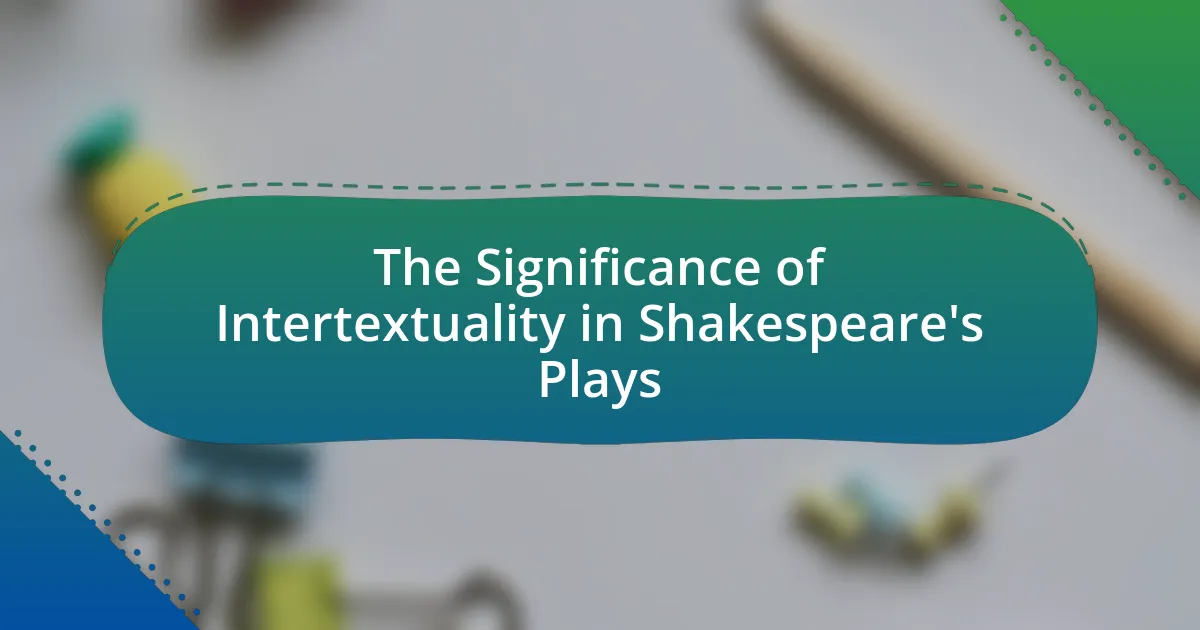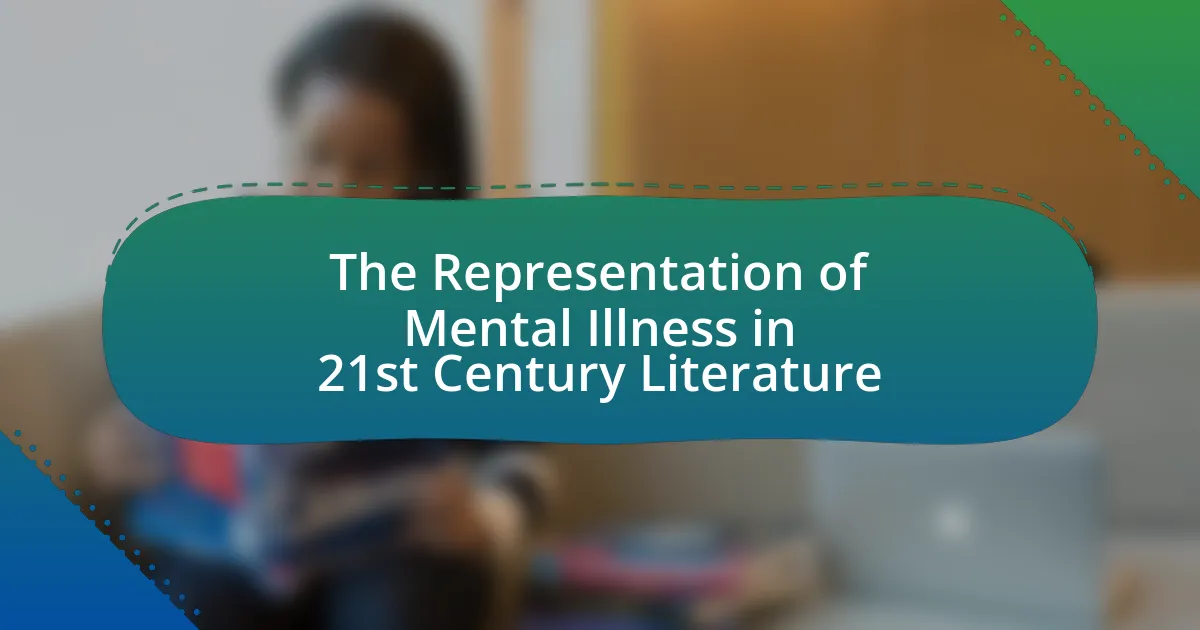The article examines the Stream of Consciousness technique in Modernist narratives, a literary method that captures the continuous flow of a character’s thoughts and feelings, often disregarding traditional narrative structures. It explores the emergence of this technique in the early 20th century, influenced by historical events and psychological theories, and highlights key authors such as James Joyce and Virginia Woolf. The article also discusses the defining characteristics of Stream of Consciousness, its impact on character development and plot structure, and the challenges readers face when engaging with this narrative style. Notable examples from literature are provided to illustrate the effectiveness of this technique in conveying the complexities of human consciousness.
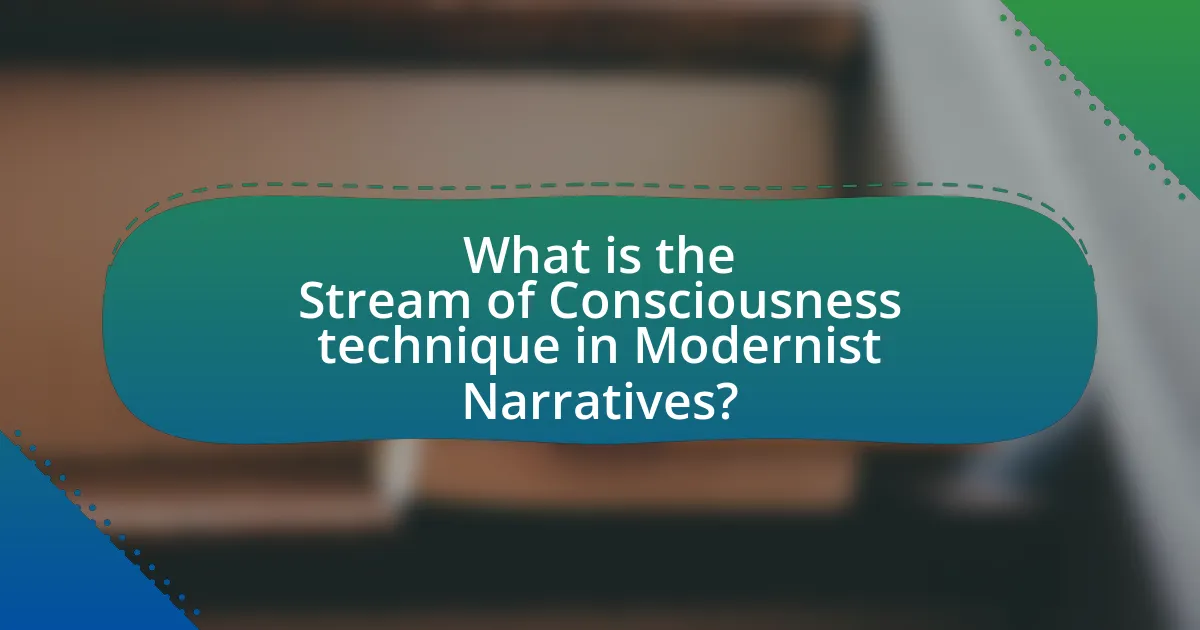
What is the Stream of Consciousness technique in Modernist Narratives?
The Stream of Consciousness technique in Modernist Narratives is a literary method that captures the continuous flow of a character’s thoughts and feelings. This technique allows authors to present a character’s inner experiences in a way that mimics natural thought processes, often disregarding traditional narrative structures. Notable examples include James Joyce’s “Ulysses” and Virginia Woolf’s “Mrs. Dalloway,” where the narrative shifts fluidly between thoughts, memories, and sensory experiences, reflecting the complexity of human consciousness. This approach emphasizes subjective experience and often blurs the line between reality and perception, showcasing the fragmented nature of modern life.
How did the Stream of Consciousness technique emerge in literature?
The Stream of Consciousness technique emerged in literature primarily in the early 20th century as a response to traditional narrative forms. This technique was notably popularized by writers such as James Joyce and Virginia Woolf, who sought to depict the inner thoughts and feelings of characters in a more fluid and unstructured manner. The emergence of this technique coincided with the Modernist movement, which emphasized a break from established conventions and explored new ways of representing reality. The use of Stream of Consciousness allowed authors to capture the complexities of human consciousness, reflecting the fragmented and often chaotic nature of thought processes, as seen in Joyce’s “Ulysses” and Woolf’s “Mrs. Dalloway.”
What historical and cultural factors influenced its development?
The development of stream of consciousness in modernist narratives was influenced by historical factors such as the aftermath of World War I and the rise of psychological theories, particularly those of Sigmund Freud. The disillusionment following the war prompted writers to explore new narrative techniques that reflected the fragmented nature of human experience. Additionally, the cultural shift towards individualism and the exploration of inner thoughts and emotions, as seen in the works of authors like Virginia Woolf and James Joyce, further shaped this literary style. These writers utilized stream of consciousness to convey the complexities of human consciousness, illustrating how external events impact internal thought processes.
Who were the key authors associated with this narrative style?
Key authors associated with the stream of consciousness narrative style include Virginia Woolf, James Joyce, and William Faulkner. Virginia Woolf utilized this technique in works like “Mrs. Dalloway,” where she explored characters’ inner thoughts and perceptions. James Joyce is renowned for his groundbreaking use of stream of consciousness in “Ulysses,” which intricately captures the flow of thoughts and experiences of its characters. William Faulkner employed this style in novels such as “The Sound and the Fury,” showcasing the complexity of human consciousness through fragmented narratives. These authors significantly contributed to the development and popularization of the stream of consciousness technique in modernist literature.
What are the defining characteristics of Stream of Consciousness in Modernist Narratives?
Stream of Consciousness in Modernist Narratives is characterized by the portrayal of a character’s inner thoughts and feelings in a continuous flow, often disregarding conventional narrative structure. This technique allows for a deep exploration of the psyche, revealing the complexities of human consciousness. Notable examples include Virginia Woolf’s “Mrs. Dalloway” and James Joyce’s “Ulysses,” where the narrative often shifts between thoughts, memories, and sensory experiences without clear transitions. The use of fragmented syntax and non-linear timelines further emphasizes the chaotic nature of thought processes, reflecting the influence of psychological theories, such as those proposed by Sigmund Freud.
How does this technique differ from traditional narrative styles?
Stream of consciousness differs from traditional narrative styles by prioritizing the inner thoughts and feelings of characters over structured plot development. Traditional narratives typically follow a linear progression with clear exposition, rising action, climax, and resolution, while stream of consciousness presents a more fragmented and non-linear approach, reflecting the chaotic nature of human thought. This technique allows for a deeper psychological exploration, as seen in works like James Joyce’s “Ulysses,” where the narrative flows seamlessly between thoughts, memories, and sensory experiences, creating a more immersive and intimate connection with the character’s psyche.
What role does interior monologue play in this technique?
Interior monologue serves as a crucial mechanism in the stream of consciousness technique, allowing authors to convey a character’s thoughts and feelings in a direct and unfiltered manner. This technique immerses readers in the subjective experience of characters, revealing their inner conflicts, motivations, and perceptions in real-time. For instance, in Virginia Woolf’s “Mrs. Dalloway,” the use of interior monologue enables a deep exploration of Clarissa Dalloway’s psyche, illustrating her reflections on life, time, and identity. This method enhances narrative depth and fosters a connection between the reader and the character’s emotional landscape, making the internal experience as significant as external events.
Why is Stream of Consciousness significant in Modernist literature?
Stream of Consciousness is significant in Modernist literature because it captures the inner thoughts and feelings of characters in a way that reflects the complexities of human consciousness. This narrative technique allows authors like James Joyce and Virginia Woolf to explore subjective experiences and fragmented realities, breaking away from traditional linear storytelling. For instance, Joyce’s “Ulysses” employs this technique to present the thoughts of its characters in real-time, illustrating the chaotic nature of thought processes. This approach aligns with Modernist themes of alienation and dislocation, emphasizing the individual’s psychological landscape in a rapidly changing world.
How does it reflect the complexities of human thought and experience?
Stream of consciousness in modernist narratives reflects the complexities of human thought and experience by capturing the fluid and often chaotic nature of inner monologue. This narrative technique allows authors to present thoughts as they occur, mirroring the non-linear and fragmented way humans process emotions and memories. For instance, Virginia Woolf’s “Mrs. Dalloway” illustrates this through characters’ shifting thoughts and perceptions, revealing their psychological depth and the influence of societal pressures. Such representation aligns with psychological theories, like those of William James, who emphasized the continuous flow of consciousness, thereby validating the technique’s effectiveness in portraying the intricacies of human experience.
What themes are commonly explored through this narrative style?
The themes commonly explored through the stream of consciousness narrative style include the complexity of human thought, the fluidity of time, and the nature of identity. This narrative technique allows authors to delve deeply into characters’ inner experiences, revealing their thoughts and emotions in a non-linear fashion. For instance, Virginia Woolf’s “Mrs. Dalloway” illustrates the theme of time by juxtaposing past memories with present experiences, showcasing how they intertwine in the characters’ minds. Additionally, James Joyce’s “Ulysses” explores identity through the fragmented thoughts of its protagonist, Leopold Bloom, emphasizing the multiplicity of self. These examples demonstrate how stream of consciousness effectively captures the intricacies of human consciousness and the subjective experience of reality.
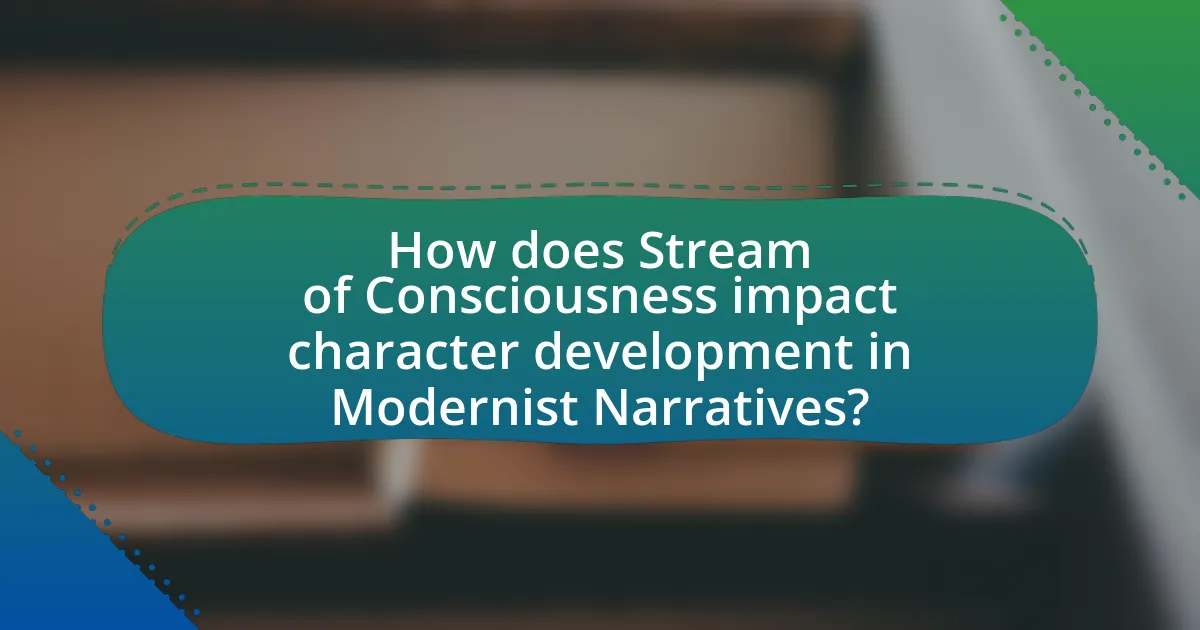
How does Stream of Consciousness impact character development in Modernist Narratives?
Stream of Consciousness significantly impacts character development in Modernist narratives by providing an intimate glimpse into characters’ thoughts and emotions. This narrative technique allows authors to depict the inner workings of characters’ minds, revealing their motivations, fears, and desires in a way that traditional narrative forms cannot. For instance, in Virginia Woolf’s “Mrs. Dalloway,” the use of Stream of Consciousness enables readers to experience Clarissa Dalloway’s reflections and memories, which shape her identity and influence her actions throughout the story. This method deepens character complexity and fosters a more profound emotional connection between the reader and the character, illustrating how internal dialogue can drive character evolution and thematic exploration in Modernist literature.
In what ways does this technique enhance character depth?
The technique of stream of consciousness enhances character depth by providing direct access to a character’s thoughts and emotions, allowing readers to experience their internal struggles and motivations in real-time. This narrative style captures the complexity of human consciousness, revealing the nuances of a character’s psyche that traditional narrative techniques may overlook. For instance, in Virginia Woolf’s “Mrs. Dalloway,” the use of stream of consciousness allows readers to understand Clarissa Dalloway’s reflections on her past and present, illustrating her existential concerns and emotional turmoil. This immersive approach fosters a deeper connection between the reader and the character, as it portrays the fluidity of thought and the impact of memory on identity.
How does it allow readers to access a character’s inner thoughts?
Stream of consciousness allows readers to access a character’s inner thoughts by presenting their thoughts and feelings in a continuous flow, mimicking natural thought processes. This narrative technique often employs techniques such as free association, fragmented syntax, and non-linear timelines, which reflect the complexity and spontaneity of human consciousness. For example, in Virginia Woolf’s “Mrs. Dalloway,” the protagonist’s inner monologue reveals her memories and emotions in real-time, providing deep insights into her psyche. This method effectively immerses readers in the character’s mental state, enhancing emotional engagement and understanding.
What are the implications of fragmented narrative on character perception?
Fragmented narrative significantly alters character perception by presenting characters through disjointed thoughts and experiences, which can create a more complex and multifaceted understanding of their psyche. This narrative style often reflects the chaotic nature of human consciousness, allowing readers to engage with characters on a deeper emotional level. For instance, in Virginia Woolf’s “Mrs. Dalloway,” the fragmented structure reveals the inner turmoil and fragmented identities of characters, enhancing the reader’s empathy and insight into their motivations. Such narratives challenge traditional linear storytelling, prompting readers to piece together character identities and emotional states, ultimately leading to a richer, albeit more challenging, interpretation of character depth and development.
How does Stream of Consciousness influence plot structure in Modernist Narratives?
Stream of Consciousness significantly influences plot structure in Modernist narratives by prioritizing the internal thoughts and feelings of characters over traditional linear storytelling. This technique allows authors like Virginia Woolf and James Joyce to explore complex psychological landscapes, creating a narrative that often lacks a clear beginning, middle, or end. For instance, in Joyce’s “Ulysses,” the plot unfolds through the fragmented thoughts of its characters, reflecting their consciousness rather than adhering to chronological events. This approach results in a more immersive experience, as readers engage with the characters’ subjective realities, thereby reshaping the conventional understanding of plot and narrative progression.
What are the effects of non-linear storytelling on reader engagement?
Non-linear storytelling significantly enhances reader engagement by creating a more immersive and interactive experience. This narrative structure encourages readers to actively piece together the plot, fostering deeper cognitive involvement and emotional investment. Research indicates that non-linear narratives can lead to increased curiosity and motivation, as readers seek to understand the connections between fragmented story elements. For instance, a study published in the journal “Cognitive Science” by researchers at the University of California found that readers of non-linear texts reported higher levels of engagement and satisfaction compared to those reading linear narratives. This engagement is often attributed to the challenge and novelty presented by non-linear storytelling, which stimulates critical thinking and personal interpretation.
How does this technique challenge traditional plot progression?
The technique of stream of consciousness challenges traditional plot progression by prioritizing the inner thoughts and feelings of characters over a linear narrative structure. This method often results in fragmented timelines and non-sequential events, which diverge from conventional storytelling that typically follows a clear beginning, middle, and end. For instance, in Virginia Woolf’s “Mrs. Dalloway,” the narrative shifts between past and present, reflecting the characters’ mental states rather than adhering to chronological order, thereby emphasizing subjective experience over objective plot development. This approach disrupts reader expectations and invites deeper engagement with the characters’ psychological landscapes, illustrating the complexity of human consciousness.
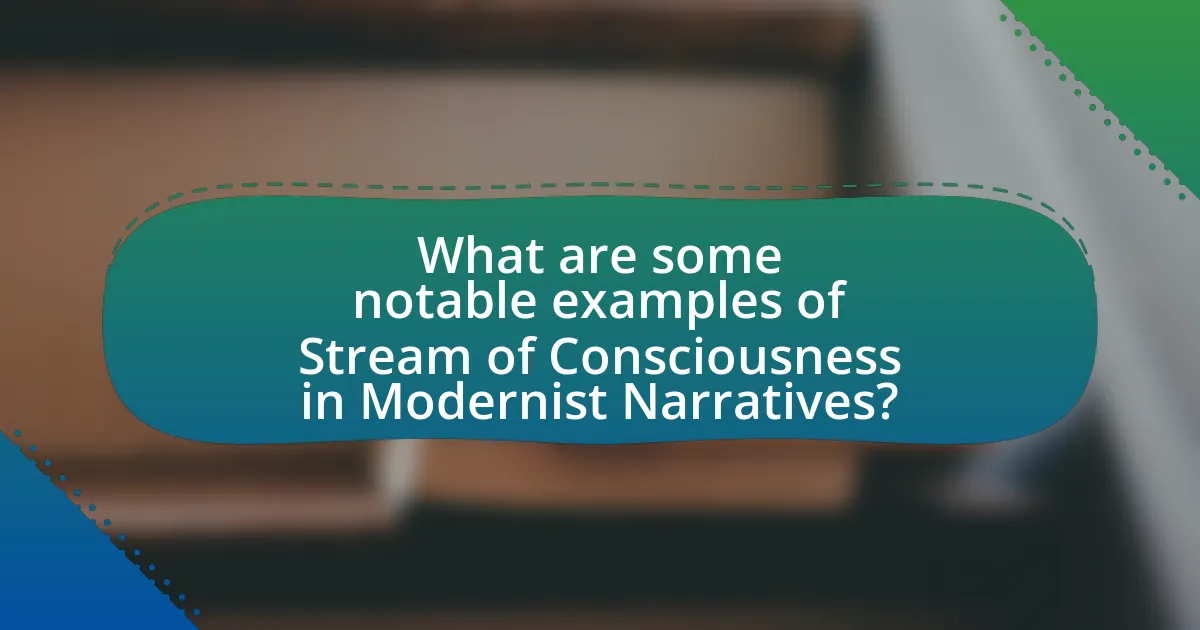
What are some notable examples of Stream of Consciousness in Modernist Narratives?
Notable examples of Stream of Consciousness in Modernist narratives include James Joyce’s “Ulysses,” Virginia Woolf’s “Mrs. Dalloway,” and William Faulkner’s “The Sound and the Fury.” In “Ulysses,” Joyce employs this technique to explore the inner thoughts of characters, particularly Leopold Bloom, capturing the flow of consciousness in real-time. Woolf’s “Mrs. Dalloway” similarly delves into the minds of its characters, revealing their thoughts and emotions through a fluid narrative style. Faulkner’s “The Sound and the Fury” uses multiple perspectives and fragmented timelines to convey the consciousness of its characters, particularly through the character Benjy, whose perception of time and reality is nonlinear. These works exemplify the Modernist focus on subjective experience and the complexity of human thought.
Which works exemplify the use of this technique effectively?
James Joyce’s “Ulysses” exemplifies the use of stream of consciousness effectively, showcasing the inner thoughts and feelings of characters in real-time. Virginia Woolf’s “Mrs. Dalloway” also employs this technique, allowing readers to experience the characters’ mental processes and perceptions fluidly. Both works illustrate how stream of consciousness can convey complex emotional landscapes and the intricacies of human thought, making them seminal examples in modernist literature.
What specific passages illustrate the Stream of Consciousness style?
Specific passages that illustrate the Stream of Consciousness style include the interior monologues found in James Joyce’s “Ulysses,” particularly in the “Penelope” chapter, where Molly Bloom’s thoughts flow freely without conventional punctuation. Another example is Virginia Woolf’s “Mrs. Dalloway,” where Clarissa Dalloway’s reflections shift rapidly between past and present, capturing her inner experiences. These passages exemplify the technique by presenting characters’ thoughts in a continuous, unstructured manner, reflecting their consciousness in real-time.
How do these examples contribute to the overall themes of the narratives?
The examples of stream of consciousness in modernist narratives enhance the overall themes by illustrating the complexity of human thought and perception. This narrative technique allows authors to depict characters’ inner experiences, revealing their psychological depth and existential struggles. For instance, in James Joyce’s “Ulysses,” the fragmented thoughts of Leopold Bloom reflect the chaotic nature of modern life, emphasizing themes of identity and the search for meaning. Similarly, Virginia Woolf’s use of stream of consciousness in “Mrs. Dalloway” captures the fluidity of time and memory, reinforcing themes of mental health and social connection. These examples collectively demonstrate how stream of consciousness serves as a powerful tool to explore the intricacies of consciousness, thereby deepening the thematic resonance of modernist literature.
What challenges do readers face when engaging with Stream of Consciousness narratives?
Readers face significant challenges when engaging with Stream of Consciousness narratives, primarily due to the non-linear structure and fragmented thoughts presented in the text. This narrative style often lacks traditional plot development and clear character arcs, making it difficult for readers to follow the storyline or connect with characters. Additionally, the use of interior monologue can lead to confusion, as readers must navigate shifts in time, perspective, and context without explicit guidance. Research indicates that this complexity can result in cognitive overload, as readers struggle to piece together the narrative threads (Keen, 2007, “Narrative Form”). Consequently, the immersive experience intended by the author may instead lead to frustration and disengagement for some readers.
How can readers better understand and appreciate this narrative style?
Readers can better understand and appreciate the stream of consciousness narrative style by actively engaging with the text and recognizing its unique structure. This style often mirrors the natural flow of thoughts, emotions, and sensory experiences, which can be disjointed and nonlinear. By paying attention to the inner monologues and fragmented thoughts of characters, readers can gain insight into their psychological states and motivations.
For instance, in Virginia Woolf’s “Mrs. Dalloway,” the narrative shifts seamlessly between characters’ thoughts, allowing readers to experience their perceptions and feelings in real-time. This technique enhances emotional depth and creates a more immersive reading experience. Understanding the historical context of modernism, which sought to break away from traditional narrative forms, also helps readers appreciate the innovative aspects of this style.
What strategies can be employed to navigate complex narratives?
To navigate complex narratives, readers can employ strategies such as breaking down the text into smaller sections, identifying key themes, and utilizing character maps. Breaking down the text allows readers to focus on manageable parts, making it easier to understand intricate plot developments. Identifying key themes helps in grasping the underlying messages and connections within the narrative. Utilizing character maps provides a visual representation of relationships and motivations, aiding in comprehension of character dynamics. These strategies are effective as they enhance engagement and facilitate a deeper understanding of the narrative structure, particularly in modernist works that often employ stream of consciousness techniques.
What practical tips can enhance the reading experience of Stream of Consciousness narratives?
To enhance the reading experience of Stream of Consciousness narratives, readers should engage in active reading techniques such as annotating the text and summarizing passages. Active reading helps to clarify complex thoughts and emotions presented in the narrative, which often lacks traditional structure. Additionally, readers can benefit from reading aloud to better grasp the rhythm and flow of the prose, as this style often mimics natural speech patterns. Research indicates that reading aloud can improve comprehension and retention, making it particularly useful for dense literary forms. Furthermore, familiarizing oneself with the author’s background and the historical context of the work can provide deeper insights into the narrative’s themes and techniques, enriching the overall reading experience.



